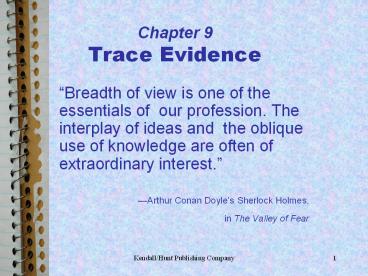Chapter 9 Trace Evidence - PowerPoint PPT Presentation
1 / 19
Title:
Chapter 9 Trace Evidence
Description:
Chapter 9 Trace Evidence Breadth of view is one of the essentials of our profession. The interplay of ideas and the oblique use of knowledge are often of ... – PowerPoint PPT presentation
Number of Views:152
Avg rating:3.0/5.0
Title: Chapter 9 Trace Evidence
1
Chapter 9Trace Evidence
- Breadth of view is one of the essentials of our
profession. The interplay of ideas and the
oblique use of knowledge are often of
extraordinary interest. - Arthur Conan Doyles
Sherlock Holmes, - in The Valley of Fear
2
Trace Evidence
Students will learn
- How to apply deductive reasoning to analytical
data. - How to follow qualitative analytical schemes.
- How to gather and use information to solve
problems.
3
Trace Evidence
Students will be able to
- Identify metals.
- Identify traces of white powder.
- Classify lip prints.
- Use chromatography to compare lipsticks.
- Design and conduct scientific investigations.
- Identify questions and concepts that guide
scientific investigations.
4
Trace Evidence
- Trace evidence is physical evidence found in
small amounts at a crime scene. Common examples
would be hair, fiber, paint chips, body fluids,
stains, powders, explosive residue, glass
particles, vegetative matter, metal particles,
and soil. It may also include more unusual types
of evidence.
5
Unusual Types ofTrace Evidence
- A torn piece of paper
- Itching powder
- Ashes
- A spider
- A match
- Grease
- Linoleum
6
Physical andChemical Properties
- Physical property A characteristic that does
not involve a change in the identity of a
substance, such as odor, color, boiling point,
density, refractive index. - Chemical property A characteristic that
determines how a substance will change into
another substance with different physical
properties.
7
Metal Analysis
- Bits of metal can be identified from their
physical and chemical properties. - Solid particlesmicroscopic examination,
magnetism, malleability, density, color,
solubility, reactivity - Dissolved metalsseparation by chromatography
with comparison of Rf values to known metals,
specific reactions and color tests
8
Product Liability
- Solid metal particles found in a loaf of bread.
- Were they in the flour from the manufacturer?
- Or were they introduced by the plaintiff for
personal gain? - Their identity answers these questions.
9
Analysis of Metal Particles
10
Environmental Contamination
- Seasonal flooding caused crop failure and
livestock sickness - The water was tested by chromatography
- The separated metals had to be located with uv
light - The spots were developed chemically and compared
to standards
11
Environmental Pollution
- The metals were identified, but where did they
come from? - A magnet manufacturer?
- A maker of brass hardware?
- A rechargeable battery company?
12
Trace Evidence Qualitative Analysis
- When investigators find substances at the scene
of a crime and send them to the laboratory for
identification, the forensic chemist uses
several techniques or lab tests to identify them.
One of these techniques is qualitative analysis. - A number of white powders that appear the same
can be identified by their physical and chemical
properties.
13
Qualitative Analysis
Microscopic Examination
14
Qualitative Analysis
- Solubility
- pH
- Chemical reactions
- Color
- Precipitate formation
- Evolution of gas
15
A Historical Crime
- In 1912, Emile Gourbin was a bank clerk in
Lyons, France. He came under suspicion of
strangling his girl friend, Marie Latelle.
Gourbin was arrested but had what appeared to be
an air-tight alibi. Edmond Locard went to
Gourbins cell and removed scrapings from under
his fingernails. The scrapings contained tissue
possibly from Maries neck, but this was not
provable. Locard noticed that the tissue was
coated with a pink dust, which he identified as
rice starch. On the particles he found bismuth,
magnesium stearate, zinc oxide, and a reddish
iron oxide pigment called Venetian red.
Examination of the face powder used by Marie
revealed that a powder prepared for her by a
Lyons druggist was similar in composition. In
these days of mass-produced face powder, this
evidence would have far less significance.
However, in 1912, because of the special
preparation, it led to the confession of Gourbin.
16
A More Recent Crime
- A bank robber was startled by an alarm just as
the teller handed her the money. She grabbed it
and in her haste to get away, ran smack dab into
a glass door. Nevertheless, she recovered and got
away. Subsequent examination of the door revealed
a red lipstick imprint of the perpetrators
mouth. Later police picked up a suspect, but
needed evidence to link her to the robbery. - http//www.hbo.com/autopsy/episode/episode_6
_the_telltale_imprint.html
17
Lip Prints
- Lip prints are different and can be used to
identify suspects. There are several general
patterns
18
Lip Prints
- What happened?
- Of several suspects, one was identified by
matching his lip print to that on the bank door. - The lipstick used by the suspect could also have
been compared to the residue on the door. How?
19
Chromatography of Lipsticks
- Thin layer chromatograph (TLC) can be used to
separate the components of a lipstick. The
chromatograms can then be compared for a match.































